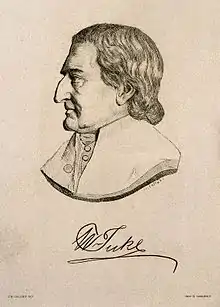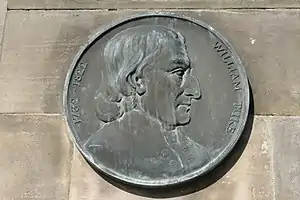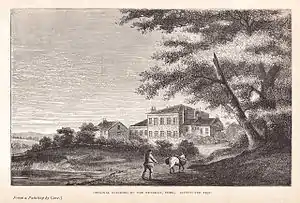William Tuke
William Tuke (24 March 1732 – 6 December 1822) was an English tradesman, philanthropist and Quaker, who promoted more humane methods of custody and care for people with mental disorders, using "gentler" methods that came to be known as moral treatment. He played a major part in founding The Retreat at Lamel Hill in York for treating mental-health needs. Tuke and his wife Esther Maud supported strict adherence to Quaker principles. He was an abolitionist, a patron of the Bible Society, and an opponent of the East India Company's inhumane practices.


Early life
William Tuke was born on 24 March 1732 in York into a prominent Quaker family. His father Samuel was a stuff-weaver and shopkeeper, who died when Tuke was 16. His mother Ann died seven years later. Tuke attended boarding school for two or three years, after which he pursued further studies under clergymen. At age 14, he began an apprenticeship at his aunt's wholesale tea business, which he inherited on her death in 1746.[1]
Family life
Tuke married Elizabeth Hoyland in 1754 and fathered four children. After Elizabeth died giving birth to their fifth child, Tuke met and married Esther Maud in 1765. Tuke and his wife were deeply involved in the Friends community and advocated stricter adherence to Quaker principles. For five decades, he travelled to London for the Yearly Meeting, serving as clerk there in 1783. Meanwhile, Tuke remained involved in the family business alongside his eldest son and business partner, Henry.[1] Ann Tuke, his daughter by Esther Maud, married William Alexander of the prominent Ipswich Quaker banking family.[2]
The Retreat
In 1791, William Tuke was moved by an incident involving Hannah Mills, a melancholic Quaker widow, who died unexpectedly at York Lunatic Asylum. Although her cause of death was unclear, mistreatment was suspected and the managers had forbidden Mills from having visitors. Tuke's daughter Ann proposed founding a mental institution run by Quakers for their own members. At a Society of Friends meeting in March 1792,[3] Tuke presented his plan for those who "laboured under that most afflictive dispensation — the loss of reason."[4] However, the proposal met with significant opposition. Some members felt such an institution was unnecessary, while others saw it as overstepping the jurisdiction of a Quaker community. The small minority of supporters included Tuke's son, Henry, and the grammarian Lindley Murray.[1]
During a visit to St. Luke's Hospital in London, Tuke witnessed appalling conditions for patients. He was particularly affected by a naked female patient who had been chained to a wall. Tuke believed the abuse was not cruel in intent, but marked a lack of effective alternatives.[4]

By 1795, financial and social support from the community was still limited. The Society of Friends eventually approved the plan when Tuke's friend, Lindley Murray, suggested raising funds through annuities. Tuke bought 11 acres of land (4.5 ha) for £938 and worked closely with a London architect, John Bevans, to carry out his vision for the new asylum. Unlike other institutions at the time, York Retreat featured long, airy corridors that allowed patients to stroll, even if they were kept from going outside.[4] A month after the first patients arrived in June 1796, the unexpected death of its superintendent, Timothy Maud, forced Tuke to step in and run the Retreat himself.[1]
William Tuke allowed his doctors to make their own observations and apply them in practice. Bleeding and other traditional remedies were abandoned in favour of gentler methods, such as warm baths for patients with melancholia. Tuke believed that physical and mental health were inextricably linked and stressed the need for proper diet and exercise. He sought to instil a sense of reason, not fear, and limited the use of physical restraints. Patients were encouraged to make themselves comfortable and often took up tasks like sewing and knitting.[4]
The approach was widely derided at first. William Tuke noted, "All men seem to desert me."[5] However, it eventually became famous worldwide as a model of more humane and psychologically based approaches.[5]
Other work
Outside his work at the Retreat, Tuke helped to found three Quaker schools: Ackworth School, Bootham School, and Trinity Lane Quaker Girls' School.[6] The last was run by Tuke's second wife Esther until her death in 1794. The Tuke family continued to run it until 1812, by which time 500 students had passed through.[1]
As a patron of the Bible Society, Tuke attended its meetings and made generous donations.[7] Tuke campaigned against the slave trade and supported the abolitionist William Wilberforce in the 1806 Yorkshire parliamentary election.[6]
Tuke was one of few voices in Britain opposing the East India Company for its inhumanity in other countries.[8] He also subscribed to the African Institution, which set out to create a viable, civilized refuge for freed slaves in Sierra Leone, Africa.[9]
Towards the end of his career, a resurgence of patient abuse at York Asylum prompted Tuke to take to the local press and demand urgent reform. Tuke provided evidence to the Select Committee on Madhouses in May 1815, which led to further inquiries and passage of the County Asylums Act in 1828.[1]
Final years and death
Tuke remained involved with the Retreat until he became blind at the age of 82. He died on 6 December 1822 after a paralytic attack.[4]
Legacy
Several of Tuke's family pursued similar philanthropic work. The York Retreat was founded by his son Henry (1755–1815), at whose request his own son Samuel wrote an 1813 account of it and popularized the principles of "moral treatment". Samuel's son James Hack Tuke also helped to manage the York Retreat, while his brother Daniel Hack Tuke co-wrote A Manual of Psychological Medicine (1858) and became a leading medical expert in insanity.[10] His daughter, Sarah Tuke Grubb, founded a school in Ireland.[11]
References
- Glover, Mary R.; Glover, Janet R., eds. (1 May 1984). The Retreat, York: Early Quaker Experiment in the Treatment of Mental Illness. York, England: William Sessions Limited. ISBN 9780900657887.
- "The Descendants of un-named Alexander" (PDF). Retrieved 17 March 2020.
- Thomas Bewley. "Madness to Mental Illness. A History of the Royal College of Psychiatrists. Online archive 1, William Tuke (1732–1822)" (PDF).
- Kibria, A. A.; Metcalfe, N. H. (2016). "A biography of William Tuke (1732–1822): Founder of the modern mental asylum". Journal of Medical Biography. 24 (3): 384–388. doi:10.1177/0967772014533059. PMID 24944052. S2CID 39683043.
- Samuel, Bill. "Quaker Tour of England – The Retreat Mental Hospital – QuakerInfo.com". www.quakerinfo.com. Retrieved 28 February 2017.
- Digby, Anne (2004). "Oxford DNB article: Tuke, William". Oxford Dictionary of National Biography. 1 (online ed.). Oxford University Press. doi:10.1093/ref:odnb/27810. Retrieved 28 February 2017. (Subscription or UK public library membership required.)
- EDITOR, FORBES WINSLOW (1 January 1855). THE JOURNAL OF PSYCHOLOGICAL MEDICINE AND MENTAL PATHOLOGY. VOL. VIII.CS1 maint: extra text: authors list (link)
- "Loot: in search of the East India Company". openDemocracy. Retrieved 28 February 2017.
- Sixth Report of the Committee of the African Institution. London: African Institution. 1812.
- "BBC – History – Historic Figures: William Tuke (1732–1822)". Retrieved 28 February 2017.
- Mitchell, Jonathan Paul. "Religious Melancholia and the York Retreat 1730–1830" (PDF). The University of Leeds.
External links
- Claus Bernet (2009). "William Tuke". In Bautz, Traugott (ed.). Biographisch-Bibliographisches Kirchenlexikon (BBKL) (in German). 30. Nordhausen: Bautz. col. 1527–1530. ISBN 978-3-88309-478-6.
- BBC Website – brief William Tuke biography
- York Quaker memorial statement of 1823 concerning William Tuke from Google Book search.
- The Tuke Institute an independent charity
- Chisholm, Hugh, ed. (1911). . Encyclopædia Britannica. 27 (11th ed.). Cambridge University Press. p. 365.
- Tuke pedigree